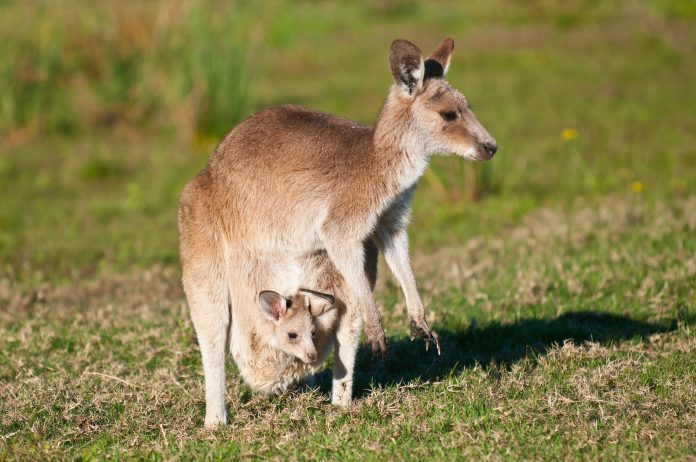The Sunshine Coast’s only 24/7 wildlife rescue service has been struggling to cope with up to 2500 callouts during the past year without a dedicated transport vehicle.
The cries for help are made to the Wildlife Rescue Sunshine Coast hotline as creatures lie injured, sick and dying by the side of a road or in the heart of suburbia.
Nearly 400 calls from January to April this year alone have been for helpless kangaroos, wallabies and their joeys.
WRSC founder Claire Smith quotes alarming statistics that include a 1007% jump in the death rate of these macropods since 2018, due to shrinking habitat and bourgeoning development in the region.
The charity organisation’s 18 rescuers are on call 24 hours a day, seven days a week, 365 days a year to deal with the problem.
But after the “animal ambulance” broke down about a year ago, they have had to jump in their own vehicles and rush anywhere within a 2000sq km area servicing coastal and hinterland towns and suburbs from Cooroy in the north to Beerwah in the south – without a moment’s thought to cleaning costs or car wear and tear.
And each time, they know that despite their desperate efforts and training, they probably have only a 30% chance of being able to save any bird or animal in time.
But they have to try.
Anyone who can help with the campaign to get another “animal ambulance” is asked to email wrsc@gmx.com
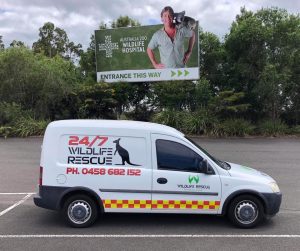
As well as the highly-trained rescuers, seven people man the WRSC hotline, and others are involved behind the scenes in administration, as well as veterinarian nurses offering best-practice recommendations and advisers such as an animal identification expert.
The service works with other Coast wildlife carers and the Gold Coast-based Wildcare Australia, which has volunteers stretching to Gympie.
“Where we differ, we just provide a dedicated first-responder service. We are the only group that operates 24 hours a day doing that,” Claire said.
The callouts cover all wildlife – from migratory and local sea birds to turtles and the occasional seal, venomous and non-venomous snakes and lizards to koalas.
Claire said about 60% of callouts were for birds but an “horrific jump” had occurred in macropod (kangaroo and wallaby) rescues.
“From January 2019 up until the end of April this year, we have attended 389 macropods on the Sunshine Coast,” she said.
“Some of those had joeys on board – another 48 on top of that of joeys that did not survive.
“That’s in just a little over two years.
“Prior to that, our average per year was 26.”
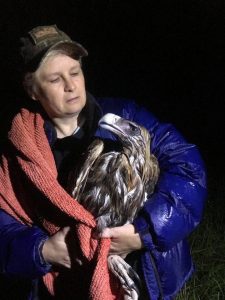
Claire said the loss of habitat due to new development areas was firmly to blame.
“(The macropods) are forced out to the margins and of course that puts them in line with traffic and dogs.
“We’re not anti-development, we are pro sustainable development – making sure the wildlife corridors are there, more thought and not just these huge swathes of land where there are just house, house, house.”
Claire said WRSC had attended an incident at the University of the Sunshine Coast two weeks ago in which an off-leash dog savaged the thighs of an eastern grey kangaroo that then had to be euthanised.
Kangaroos rarely survived such a mauling or being hit by a car.
“They develop something called cardiomyopathy,” she said.
“With kangaroos, when they experience trauma or stress, they get this release of this hormone that’s a bit like cortisol (produced by the adrenal glands in humans that help the body respond to stress or danger).
“Basically, what it does, it causes the organs to shut down if it’s not caught early enough.
“Kangaroos in the wild, if they get alerted and spooked, they get this rush of adrenalin. The first thing you’ll see them do after that is to go and drink. They drink and drink and drink water to flush those toxins through, out of their system.
“Unfortunately, when that animal has been hit by a car, it might have been there an hour, two hours, three hours. Nobody knows sometimes unless the person who hits it, reports it (to be helped).
“So, these animals are in that state of stress and shock and usually the cardiomyopathy will just stop the heart. It’s a really horrible, horrible death.”
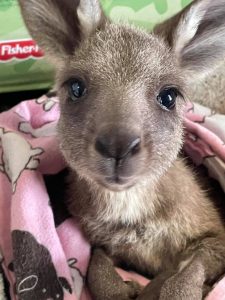
In a 2015 report commissioned by the University of the Sunshine Coast, a warning was issued about the declining local kangaroo population.
The study showed the Eastern Grey kangaroos that inhabited the campus had dwindled from 80 or 100 in 2010 to less than 19 in 2015.
Claire said only five females remained today and one male visited periodically.
“That little group of females that is left is unprotected because there is only this one buck,” she said.
“There was a young buck that was killed in 2019 at the crossroads between the Innovation Centre and Stringybark Rd. He was killed and then there was another one also killed last year.
“Now because they’re such a small group, and there is no genetic diversity, that little mob are now functionally extinct, which means that even if they’re not killed by traffic or dogs, they will just die out and that will be it.
“And that’s true all over the Coast.
“What people seem to not understand is that when things become functionally extinct, it’s the beginning of the end and local extinction is the beginning of the end for the species.
“We saw exactly the same thing happen with the thylacine (Tasmanian tiger carnivorous marsupial) back in the 1930s.
“We’re now seeing the impact of what commercial hunting did to koalas back in the 1930s when tens and tens of thousands of koalas were shot and killed for the fur trade to Europe and to the United States.
“The reason we have so much sickness in our koalas is not just because of loss of habitat, it’s also because of the lack of genetic diversity.
“When we get a lack of genetic diversity, that’s when we start to see things like koala retrovirus, chlamydia and other diseases start to become really prevalent because of the in-breeding.”
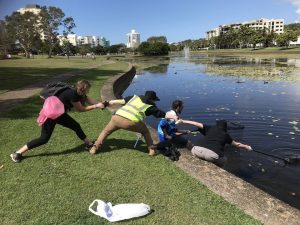
Claire brought a fresh set of eyes to the plight of Sunshine Coast wildlife when she moved from her home in Norfolk, England, to Nambour in 2001.
Having had a maternal grandfather sail across the other side of the world to start a new life and go on to become a World War I Anzac, she grew up learning about Australia. And she admits to always having a soft spot for kangaroos, which feature on our Coat of Arms.
“They are the most extraordinary creature,” said the long-time animal rescuer and carer whose first teddy bear was a mohair koala (which she still has, minus an ear and most of its fake fur).
“Just looking at them, none of that should work. They’re like a deer crossed with a huge pair of springs.
“But they’re incredibly sensitive, intelligent animals and they’re not given enough credit.
“We allow them to be harvested for export market.
“On the conservation register, they are registered as ‘of least concern’ which means that councils do not have to make any allowance for them when they are considering development applications because it is assumed that kangaroos will self-disperse.”
Help keep independent and fair Sunshine Coast news coming by subscribing to our free daily news feed. All it requires is your name and email. See SUBSCRIBE at the top of this article.
Claire had already been a champion for our wildlife, through another organisation since 2007, when she and three other long-term carers realised a need existed on the Coast for a 24-hour, reliable and dedicated rescue service.
They started the service together in 2013, and two of that core group remained when WRSC was opened up to other volunteers two years later.
Being a friend to the animals and giving a voice to the voiceless is part of Claire’s DNA, but she laments the fact that not every rescue comes with a happy ending.
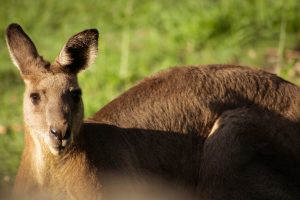
“We believe that ending suffering equals a good rescue because you wouldn’t want your domestic pet to be lying dying somewhere over two or three days so why would you want a blue-tongue lizard or a kangaroo or kookaburra just waiting to be plucked by something or just die a horrible, slow death.
“Even when we know there’s no possibility of rehabilitation, the best possible outcome then is to be put to sleep in a humane way and to end suffering.
“Unfortunately, the ending suffering rate is much, much higher than the survival rate: 70-30%, probably.”
It was vital for Australia to turn those figures around, she said.
“There are certain species that cannot sustain those heavy losses and one of those is the eastern grey kangaroo.
“Our eastern grey kangaroos that are found on the coastal strip have been here since the last ice age. They are a unique clade.
“They have not changed genetically. They have not intermingled with other kangaroos from other areas.
“We can do as many surveys and we can do as many studies that end up as white papers that end up on a shelf somewhere and nothing changes.
“I don’t know. Sometimes I feel like what I’m doing is too little too late. We’ve been shouting about this for years now.
“Wouldn’t you think you’d protect what’s on your Coat of Arms for a start?”
Towards that aim, WRSC has established the Macropod Rehabilitation Facility in the hinterland for eastern grey kangaroos and various wallabies – a stepping stone for them to complete their growth and be released.
The facility can take up to about 30 macropods at a time, weighing 5kg for a kangaroo and 3-4kg for swamp, whip tailed (pretty-faced), red-necked and black-striped wallabies, and or 1kg pademelons.
“They can be soft-released from that site into bush because it backs on to state forest,” Claire said.
“The macropods there have all been orphaned joeys.
“They can come back for a while and have support feeding. It’s a much nicer way to release macropods back into the wild.”
But it all costs money and Claire said donations to WRSC for its services were always gratefully received.
The new “animal ambulance” van was the most pressing requirement and WRSC could offer a corporate partner, car dealership or benefactor eye-catching advertising on the vehicle, as well as other social media and promotional opportunities.
Follow Sunshine Coast News on Facebook.
While some of the rescuers drove SUVs, even those vehicles often struggled to transport larger animals such as kangaroos and wallabies or even birds including pelicans comfortably – sometimes over long distances – and carrying the ladders and extendable poles needed.
Fuel cost $40,000-45,000 a year for the service. Volunteers had to be outfitted in sturdy, safe uniforms and high-vis gear to be covered by insurance, and equipment had to be updated and maintained “because we have to be ready for anything”, Claire said.
The “big-ticket” item for the future is code-named Operation Safe Haven: a plan to buy about 25ha of land for WRSC to set up a safe haven for native wildlife as well as rehabilitated animals, and to create fodder farms – planting gum saplings for koalas and grevilleas and bottlebrush for birds, for example.
An information centre on site would teach school, university and TAFE students why our native wildlife is so important, why they’ve been impacted and what can be done to turn the tide.
“I am still as much in love with Australian wildlife today as I was the very first time I saw kangaroos in the wild in North Arm,” Claire said.
“You don’t give up years and years of your life if there isn’t a really good reason for it.
“As volunteers, we give up an enormous amount in pursuit of the preservation and care of native species.
“Sometimes I feel a bit … like the elephant in the room because here’s this short, middle-aged English woman that’s talking about native wildlife to Australians – a lot of whom have very little knowledge about our wildlife.
“And that’s part of the problem: people are very detached from the environment.
“They don’t get to experience the bush.”
To report injured wildlife, call the 24/7 hotline on 0458 682 152. For more inquiries on volunteer courses, email wrsc@gmx.com.


